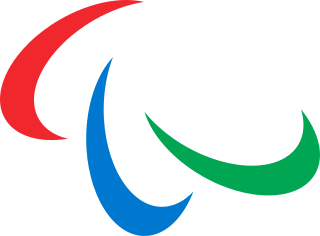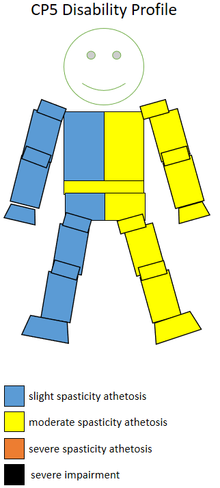
The Summer Paralympics, also known as the Games of the Paralympiad, are an international multi-sport event where athletes with physical disabilities compete. This includes athletes with mobility disabilities, amputations, blindness, and cerebral palsy. The Paralympic Games are held every four years, organized by the International Paralympic Committee. Medals are awarded in every event, with gold medals for first place, silver for second and bronze for third, a tradition that the Olympic Games started in 1904.
T35 is a disability sport classification for disability athletics' running competitions. It includes people who have coordination impairments such as hypertonia, ataxia and athetosis. This includes people with cerebral palsy. The classification is used at the Paralympic Games. The corresponding F35 classification includes club and discus throw, shot put, and javelin.
Disability sports classification is a system that allows for fair competition between people with different types of disabilities.
BC2 is a boccia classification. The class is open to people with several different types of disabilities, including cerebral palsy. BC2 players have events open to them in boccia on the Paralympic Games program.
Para-alpine skiing classification is the classification system for para-alpine skiing designed to ensure fair competition between alpine skiers with different types of disabilities. The classifications are grouped into three general disability types: standing, blind and sitting. Classification governance is handled by International Paralympic Committee Alpine Skiing. Prior to that, several sport governing bodies dealt with classification including the International Sports Organization for the Disabled (ISOD), International Stoke Mandeville Games Federation (ISMWSF), International Blind Sports Federation (IBSA) and Cerebral Palsy International Sports and Recreation Association (CP-ISRA). Some classification systems are governed by bodies other than International Paralympic Committee Alpine Skiing, such as the Special Olympics. The sport is open to all competitors with a visual or physical disability. It is not open to people with intellectual disabilities.

Para-Nordic skiing classification is the classification system for para-Nordic skiing which includes the biathlon and cross-country events. The classifications for Para-Nordic skiing mirrors the classifications for Para-Alpine skiing with some exceptions. A functional mobility and medical classification is in use, with skiers being divided into three groups: standing skiers, sit skiers and visually impaired skiers. International classification is governed by International Paralympic Committee, Nordic Skiing (IPC-NS). Other classification is handled by national bodies. Before the IPC-NS took over classification, a number of organizations handled classification based on the type of disability.

Para-archery classification is the classification system for para-archery used to create a level playing field for archers with a different range of disabilities. Governance in the sport is through the International Archery Federation. Early classification systems for the sport were created during the 1940s and based on medical classification. This has subsequently changed to a functional mobility classification with the exception of blind archery.
Disability table tennis classification is the disability sport classification process for para table tennis that is governed by the International Table Tennis Federation. The sport's classifications are open to people with physical and intellectual disabilities.
Sledge hockey classification is the classification process for people who play ice sledge hockey. The classification system is governed by the International Paralympic Committee Ice Sledge Hockey.
CP1 is a disability sport classification specific to cerebral palsy. In many sports, it is grouped inside other classifications to allow people with cerebral palsy to compete against people with other different disabilities but the same level of functionality. CP1 classified competitors are the group who are most physically affected by their cerebral palsy. They are quadriplegics.
CP2 is a disability sport classification specific to cerebral palsy. In many sports, it is grouped inside other classifications to allow people with cerebral palsy to compete against people with other different disabilities but the same level of functionality. People in this class tend to use electric wheelchairs and are quadriplegic. CP2 competitors have better upper body control when compared to CP1.
CP3 is a disability sport classification specific to cerebral palsy. In many sports, it is grouped inside other classifications to allow people with cerebral palsy to compete against people with other different disabilities but the same level of functionality. Compared higher number CP classes, they have increased issues with head movement and trunk function. They tend to use wheelchairs on a daily basis though they may be ambulant with the use of assistive devices.
CP4 is a disability sport classification specific to cerebral palsy. In many sports, it is grouped inside other classifications to allow people with cerebral palsy to compete against people with other different disabilities but the same level of functionality. Compared lower number CP classes, they have fewer issues with head movement and trunk function. They tend to use wheelchairs on a daily basis though they may be ambulant with the use of assistive devices.
CP6 is a disability sport classification specific to cerebral palsy. In many sports, it is grouped inside other classifications to allow people with cerebral palsy to compete against people with other different disabilities but the same level of functionality. Sportspeople in this class are ambulatory, and able to walk without the use of an assistive device. Their bodies are constantly in motion. The running form of people in this class is often better than their form while walking.
CP7 is a disability sport classification specific to cerebral palsy. In many sports, it is grouped inside other classifications to allow people with cerebral palsy to compete against people with other different disabilities but with the same level of functionality. Sportspeople in this class can walk but may appear to have a limp as half their body is affected by cerebral palsy.
CP8 is a disability sport classification specific to cerebral palsy. In many sports, it is grouped inside other classifications to allow people with cerebral palsy to compete against people with other different disabilities but the same level of functionality.
Cerebral palsy sport classification is a classification system used by sports that include people with cerebral palsy (CP) with different degrees of severity to compete fairly against each other and against others with different types of disabilities. In general, Cerebral Palsy-International Sports and Recreation Association (CP-ISRA) serves as the body in charge of classification for cerebral palsy sport, though some sports have their own classification systems which apply to CP sportspeople.
Les Autres sport classification is system used in disability sport for people with locomotor disabilities not included in other classification systems for people with physical disabilities. The purpose of this system is to facilitate fair competition between people with different types of disabilities, and to give credibility to disability sports. It was designed and managed by International Sports Organization for the Disabled (ISOD) until the 2005 merger with IWAS, when management switched to that organization. Classification is handled on the national level by relevant sport organizations.
LA4 is a Les Autres sport classification is an ambulatory sport classification for a sportsperson with a disability that impacts their locomotor function. People in this class may or may not uses crutches and/or braces on a daily basis. They have some issues with balance and reduced function in their upper limbs.
Wheelchair sport classification is a system designed to allow fair competition between people of different disabilities, and minimize the impact of a person's specific disability on the outcome of a competition. Wheelchair sports is associated with spinal cord injuries, and includes a number of different types of disabilities including paraplegia, quadriplegia, muscular dystrophy, post-polio syndrome and spina bifida. The disability must meet minimal body function impairment requirements. Wheelchair sport and sport for people with spinal cord injuries is often based on the location of lesions on the spinal cord and their association with physical disability and functionality.




